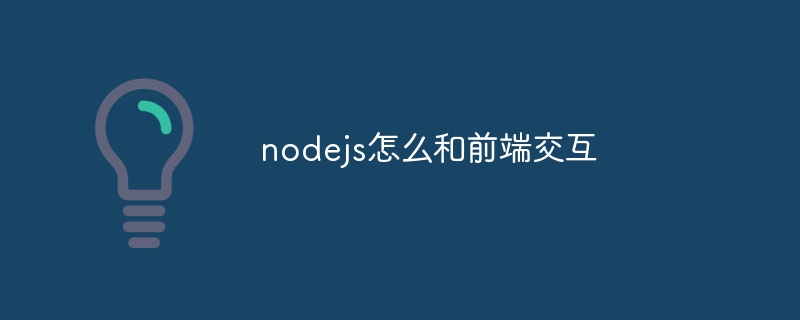How nodejs interacts with the front end
Node.js interacts with the frontend via HTTP request/response, WebSocket, and Socket.IO: Set up a Node.js server and define routes. The front end sends HTTP requests or establishes connections using WebSocket or Socket.IO. The Node.js server handles the request and returns a response or sends data over a live connection.

Node.js Interaction with the front-end
Node.js is a method for building server-side applications JavaScript runtime environment. It can interact with front-end technologies such as HTML, CSS, and JavaScript to provide dynamic and interactive web applications.
Interaction methods
Interaction between Node.js and the front-end can be carried out in the following ways:
- HTTP request/response: Node.js servers can handle HTTP requests from browsers or other clients and return HTML, JSON, or other types of responses.
- WebSocket: WebSocket is a two-way real-time communication protocol that allows a Node.js server to establish a persistent connection with a front-end for real-time transfer of data.
- Socket.IO: Socket.IO is a WebSocket library that simplifies real-time communication between Node.js and frontends. It also provides advanced features such as event handling and message namespaces.
Implementation steps
1. Create server:
const express = require('express');
const app = express();
const server = app.listen(3000);2. Define route:
app.get('/', (req, res) => {
res.send('Hello from Node.js!');
});3. Handle front-end requests:
app.post('/submit-form', (req, res) => {
const data = req.body;
// 处理表单数据...
});4. Use WebSocket:
const WebSocket = require('ws');
const wss = new WebSocket.Server({ server });
wss.on('connection', (ws) => {
// 与客户端建立 WebSocket 连接...
});5 . Using Socket.IO:
const socketIO = require('socket.io');
const io = socketIO(server);
io.on('connection', (socket) => {
// 与客户端建立 Socket.IO 连接...
});Front-end code example:
// 发送 HTTP 请求
fetch('/submit-form', {
method: 'POST',
body: JSON.stringify({ name: 'John' }),
})
.then((res) => res.json())
.then((data) => console.log(data));
// 建立 WebSocket 连接
const socket = new WebSocket('ws://localhost:3000');
socket.onopen = () => console.log('Connected to WebSocket');
// 使用 Socket.IO
const socket = io();
socket.on('connect', () => console.log('Connected to Socket.IO'));The above is the detailed content of How nodejs interacts with the front end. For more information, please follow other related articles on the PHP Chinese website!

Hot AI Tools

Undresser.AI Undress
AI-powered app for creating realistic nude photos

AI Clothes Remover
Online AI tool for removing clothes from photos.

Undress AI Tool
Undress images for free

Clothoff.io
AI clothes remover

Video Face Swap
Swap faces in any video effortlessly with our completely free AI face swap tool!

Hot Article

Hot Tools

Notepad++7.3.1
Easy-to-use and free code editor

SublimeText3 Chinese version
Chinese version, very easy to use

Zend Studio 13.0.1
Powerful PHP integrated development environment

Dreamweaver CS6
Visual web development tools

SublimeText3 Mac version
God-level code editing software (SublimeText3)

Hot Topics
 1386
1386
 52
52
 How to use bootstrap in vue
Apr 07, 2025 pm 11:33 PM
How to use bootstrap in vue
Apr 07, 2025 pm 11:33 PM
Using Bootstrap in Vue.js is divided into five steps: Install Bootstrap. Import Bootstrap in main.js. Use the Bootstrap component directly in the template. Optional: Custom style. Optional: Use plug-ins.
 The Roles of HTML, CSS, and JavaScript: Core Responsibilities
Apr 08, 2025 pm 07:05 PM
The Roles of HTML, CSS, and JavaScript: Core Responsibilities
Apr 08, 2025 pm 07:05 PM
HTML defines the web structure, CSS is responsible for style and layout, and JavaScript gives dynamic interaction. The three perform their duties in web development and jointly build a colorful website.
 How to write split lines on bootstrap
Apr 07, 2025 pm 03:12 PM
How to write split lines on bootstrap
Apr 07, 2025 pm 03:12 PM
There are two ways to create a Bootstrap split line: using the tag, which creates a horizontal split line. Use the CSS border property to create custom style split lines.
 Understanding HTML, CSS, and JavaScript: A Beginner's Guide
Apr 12, 2025 am 12:02 AM
Understanding HTML, CSS, and JavaScript: A Beginner's Guide
Apr 12, 2025 am 12:02 AM
WebdevelopmentreliesonHTML,CSS,andJavaScript:1)HTMLstructurescontent,2)CSSstylesit,and3)JavaScriptaddsinteractivity,formingthebasisofmodernwebexperiences.
 How to insert pictures on bootstrap
Apr 07, 2025 pm 03:30 PM
How to insert pictures on bootstrap
Apr 07, 2025 pm 03:30 PM
There are several ways to insert images in Bootstrap: insert images directly, using the HTML img tag. With the Bootstrap image component, you can provide responsive images and more styles. Set the image size, use the img-fluid class to make the image adaptable. Set the border, using the img-bordered class. Set the rounded corners and use the img-rounded class. Set the shadow, use the shadow class. Resize and position the image, using CSS style. Using the background image, use the background-image CSS property.
 How to resize bootstrap
Apr 07, 2025 pm 03:18 PM
How to resize bootstrap
Apr 07, 2025 pm 03:18 PM
To adjust the size of elements in Bootstrap, you can use the dimension class, which includes: adjusting width: .col-, .w-, .mw-adjust height: .h-, .min-h-, .max-h-
 How to set up the framework for bootstrap
Apr 07, 2025 pm 03:27 PM
How to set up the framework for bootstrap
Apr 07, 2025 pm 03:27 PM
To set up the Bootstrap framework, you need to follow these steps: 1. Reference the Bootstrap file via CDN; 2. Download and host the file on your own server; 3. Include the Bootstrap file in HTML; 4. Compile Sass/Less as needed; 5. Import a custom file (optional). Once setup is complete, you can use Bootstrap's grid systems, components, and styles to create responsive websites and applications.
 How to use bootstrap button
Apr 07, 2025 pm 03:09 PM
How to use bootstrap button
Apr 07, 2025 pm 03:09 PM
How to use the Bootstrap button? Introduce Bootstrap CSS to create button elements and add Bootstrap button class to add button text




